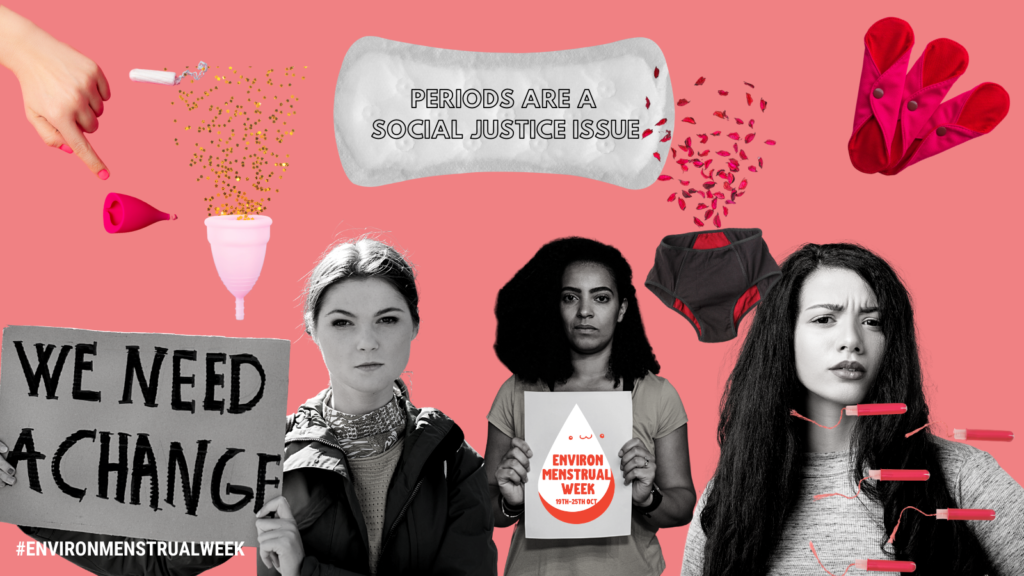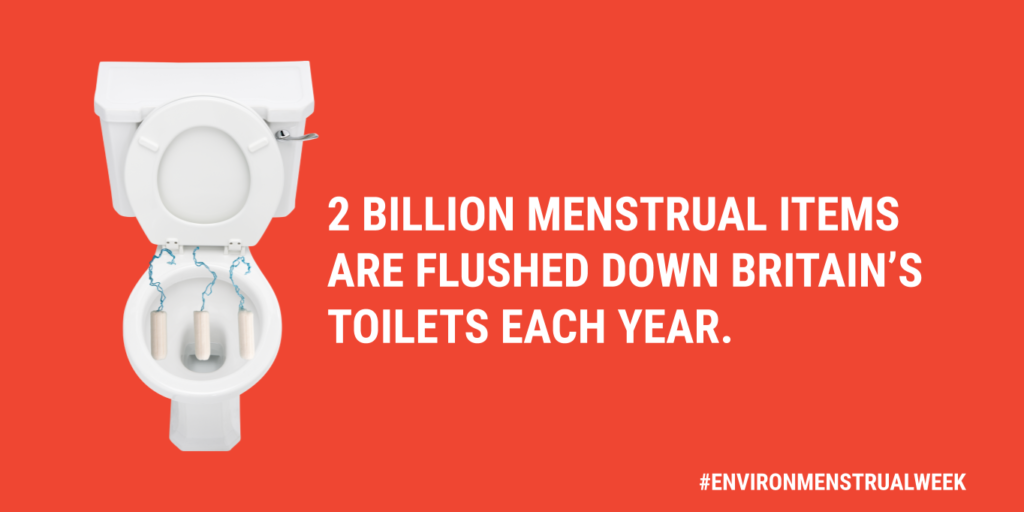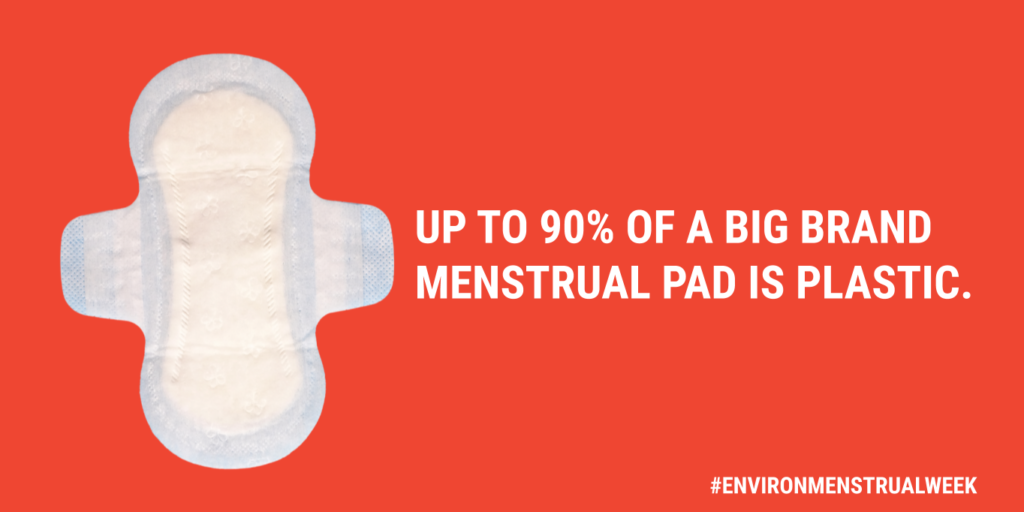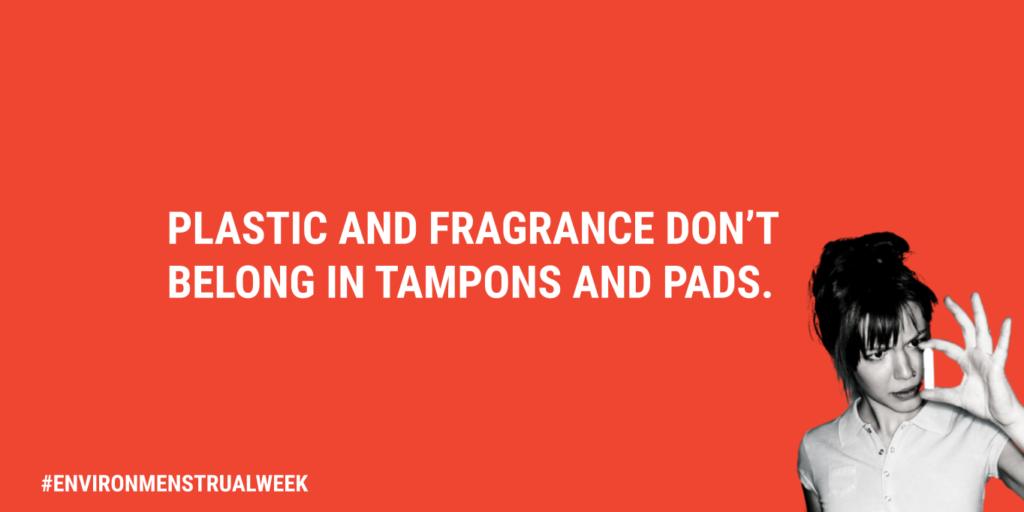This week, to shine a light on the environmental impact of menstruation, we are excited to feature an article by Environmenstrual Ambassador, Cecilia Allon and Yoga Therapist, Uma Dinsmore-Tuli.
The Environmenstrual campaign is driven by the Women’s Environmental Network (Wen). Wen fights global problems around gender, health and the environment. On this issue, their vision is:
to build communities in which people who menstruate can manage their periods without harming their health or the planet
as well as removing any taboo around menstruation.

Environmenstrual Ambassadors, like Cecilia, are working to provide unbiased period education so that people can make properly informed decisions about menstrual products. We are happy to include the below article from Uma and Cecilia, and would like to thank Wen for the research data.
***
Every month, many women will find that they have to bin or flush disposable menstrual products.
Blocking pipes and killing sea life
According to research undertaken on behalf of the Environmenstrual Campaign, there are currently 18 million people who menstruate in Britain. The average menstruator uses 11,000 disposable menstrual products in a lifetime. The disposal of these generates 200,000 tonnes of waste per year in Britain alone.
2 billion menstrual products are flushed down Britain’s toilets each year. 41% of women admit to flushing these products down the loo, contributing to the sewer blockages.

Disposal menstrual pads contain up to 90% plastic. In fact, an average pack contains the same amount of plastic as five plastic bags. This plastic takes between 500 and 800 years to degrade. But the thing about plastic is that it never goes away, it just breaks down into smaller and smaller pieces. These microplastics (defined as pieces smaller than 5mm) remain in our ecosystem harming thousands of sea creatures every day.
Plastic waste kills up to one million sea birds, 100,000 sea mammals and countless fish each year.

Figures from the Marine Conservation Society show that for every 100 metres of beach that is cleaned in Britain, 4.8 pieces of menstrual waste are found. In the UK the annual cost for the removal of single-use menstrual products, wet wipes and other related debris from beaches is estimated at €1.1 million.
The chemical element
Some menstrual products also contain fragrances, which can interfere with the balance between good and bad bacteria in your vagina. Synthetic fragrances can be made from a cocktail of up to 3,900 chemicals (styrene, chloromethane, chloroethane, chloroform, acetone, among others). Some of them are identified as potential carcinogens, irritants, hormone disruptors and reproductive toxicants.

Many of the conventional single-use menstrual products (pads and tampons) and their packaging contain plastic and other synthetic materials like rayon, adhesives, artificial fragrances and toxic chemicals, which are recognized environmental pollutants. Even traces of dioxin, created when these products are bleached white, can be found in menstrual products.
Join the Environmenstrual Campaign: What can you do?
- Only flush the 3 Ps – pee, poo and paper
- Switch to plastic free and organic cotton disposable options (suppliers of plastic free menstrual products: https://www.wen.org.uk/wp-content/uploads/Suppliers-list-july.pdf)
- Switch to a reusable menstrual product like a menstrual cup, period pants or washable pads. (Wen offers voucher codes here to help you make the switch: https://www.wen.org.uk/2008/07/14/plasticfreeperiods/ )
- Read more: there are lots of resources available to keep you informed and to help you make better decisions
Menstrual Cup
Like a tampon, a menstrual cup is inserted into the vagina but instead of absorbing blood the cup catches it. Made of flexible materials, like rubber or silicone, there are now over 100 different menstrual cups on the market. Cups catch the blood and can be used on their own for up to 12 hours. During your period, the cup is emptied, rinsed with clean cool water and then reinserted. At the end of your period, the cup needs to be sterilised before the next use. This can be done by boiling, sterilising solution or tablets, or in the microwave with the right vessels. Cups can be used for approximately 10 years and work out at approximately 20p per period.
Period Pants
Period pants are essentially leak proof knickers. You won’t need to wear a pad, a tampon or menstrual cup if you wear them during your period. Most period pants are around 3mm. They can hold around two standard tampons’ worth of menstrual blood, lasting up to 12 hours. You can now buy period pants in a large range of styles, colours and patterns. You can even buy period boxer shorts and swimwear. Period pants last for approximately 2 years. To clean, simply rinse in cool water, then put in your normal clothes wash. They may take a little longer to dry than regular pants as the gussets are thicker, so it is worth buying a couple of pairs to be worn during your period. If you need to change whilst away from home, you can seal them in a waterproof washbag.
Reusable Pads
Reusable pads come in a range of sizes, materials and patterns and are used in the same way as disposable period pads. A set of reusable pads will cost you between £10 and £35 and can last between 3 and 10 years. They can be made from 100% natural cotton, flannel, fleece or bamboo. Some contain polyester which is a type of plastic that is commonly found in clothing. If you need to change whilst away from home, you can seal them in a waterproof washbag. Make sure you read the washing instructions on whatever pads you choose. General guidance is to rinse them / soak them in cold water before popping them in the washing machine on a long cycle (30º-40º). You can also hand-wash them. Don’t use fabric softener!
About the authors
Uma Dinsmore-Tuli has written four books on yoga for women, including Yoni Shakti: A woman’s guide to power and freedom through yoga and tantra. She offers Yoga Therapy with the aim to reconnect people with cyclical wisdom and the ecology of self-care, which in turn reconnects people with the planet and their planetary responsibility.
Together with her dedicated team, Uma is dedicating her time to educating women in particular young women on how we change our beliefs around the menstrual cycle and start to use eco-friendly products that are not toxic to women or the environment (polluting our waters and filing up landfills unnecessarily) a type of sacred eco activism.
Cecilia Allon is an Environmenstrual Ambassador for WEN, Yoga Teacher specialising in yoga for women’s health and cyclical awareness, Red Tent facilitator and mother to a 12 year old daughter. Cecilia is passionate about menstruality education and believes that breaking the taboos around menstruation will lead menstruators to making healthier menstrual product choices for themselves and for this planet. Connect with Cecilia’s work at www.yogawithcecilia.co.uk
Leave a Reply